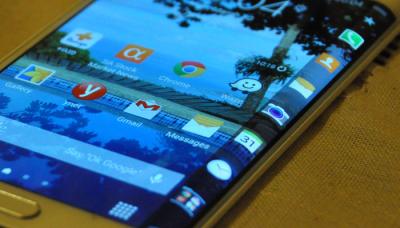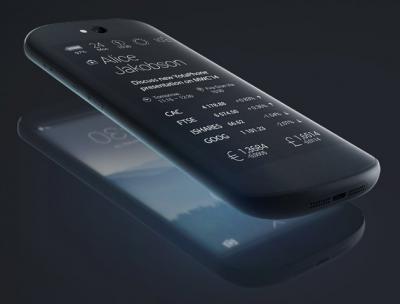Super AMOLED: introduction and market status
OLED displays use organic materials that emit light when electricity is applied. OLEDs enable emissive, bright, thin, flexible and efficient displays. OLEDs are replacing LCDs in most display applications - from smartphones and wearables to monitors and TVs.

Samsung's Super AMOLED displays, announced in 2010, are AMOLED displays for mobile devices (such as smartphones, wearables and tablets) with an integrated touch function. The thickness of the touch sensor is just 0.001 mm and this allows the screen to provide better images and to have great visibility even in direct sunlight compared with regular AMOLED displays with an external touch layer.
Samsung is producing hundreds of millions of Super AMOLED displays today, used mostly in smartphones, but also in other devices. These are considered to be some of the best displays on the market.
Super AMOLED and the Pentile matrix
Samsung's Super AMOLED displays use a Pentile matrix sub-pixel design. That means that the green sub-pixel is shared by two pixels and the display has only 2 sub-pixels per real 'pixel' compared to the classic RGB matrix design (or Real-Stripe). You can see a PenTile matrix vs a Real-Stripe one on the images below (the PenTile is on the right). Newer Super AMOLED displays use a different PenTile matrix (Diamond Pixel pattern).
Super AMOLED vs Dynamic AMOLED
In 2019 Samsung introduced its next-generation mobile display technology, which it calls Dynamic AMOLED. Basically a Dynamic AMOLED is similar to a Super AMOLED display, but it adds HDR support. Samsung's highest end smartphones adopt the company's Dynamic AMOLED 2X LTPO AMOLED displays.
Further reading
- Introduction to OLEDs
- Samsung's OLED displays
- Pentile Technology explained
- Flexible OLEDs
- OLED mobile phones
- The OLED Toolbox: a one-stop-shop for OLED information, insights, analysis and guides
Do Samsung's new OLED panels use new PHOLED materials?
A couple of days ago we reported that according to tests by DisplayMate, SDC's new 5.1" FHD Super AMOLED panel (used in the GS5) is a lot more efficient than Samsung's previous generation panels (a 27% compared to the GS4 which is actually a little smaller). DisplayMate's Raymond Soneira told us that Samsung said that the improvement mostly came from more efficient OLED materials.
This is quite interesting, and according to my own checks, it seems that indeed Samsung is using new materials. In fact, my sources say that Samsung adoped new and improved phosphorescent materials.
DisplayMate: the GS5 display is the best mobile display ever, outperforming all previous OLED and LCD panels
Last month Samsung unveiled the Galaxy S5 with its 5.1" FHD (432 PPI) Super AMOLED display. The phone is set to launch globally on April 11th, but my friend Raymond Soneira from DisplayMate received a GS5 from Samsung to test the display. And his conclusions? The GS5's display is a major improvement over the GS4 display. In fact, the GS5's AMOLED is the best mobile display ever tested at DisplayMate, outperforming all other OLED and LCD displays.

But just how is the display better than the 5" Full-HD one on the GS4 and every other mobile display on the market? DisplayMate says that the new display is features the highest brightness, the lowest reflectance, the highest color accuracy, the highest contrast rating in ambient light and the smallest brightness variation with viewing angle. That's quite impressive!
You can now pre-order AT&T's Galaxy S5 from $189.99
Samsung's Galaxy S5 is launching, as planned on April 11, and now Amazon offers the AT&T model for pre-order. Depending on the service plan, the GS5 costs $189.99 to $699.99.
The GS5 features a 5.1" FHD (432 PPI, Diamond Pixel most likely) Super AMOLED display, a 2.5 Ghz quad-core CPU, 2GB of RAM, 16MP camera (4K video support). The GS5 is dust and water resistant, and it packs a finger scanner and a heart rate sensor.
The Galaxy S5's display related innovations
When Samsung unveiled the Galaxy S5, some people (yes, including me) were a bit disappointing by the display. It seems that it's basically the display used in the GS4, only slightly larger (5.1" vs 4.99"). But it turns out that Samsung does include a couple of new display related technologies in the GS5.

According to PC Magazine, the GS5 includes a custom image chip that dynamically adjusts the color gamut and contrast based on ambient light. This makes the colors much better under different lighting conditions. And it's bound to make DisplayMate's Raymond Soneira really happy - he's been long talking about how OLED's wide color gamut can be used in ambient light conditions to improve the image quality.
Samsung sold over 200 million smartphones from the Galaxy S series
Samsung announced that it has sold over 200 million Galaxy S smartphones - including the GS1, GS2, GS3 and GS4. It probably also includes all the variants (such as the GS4 zoom and the GS4 mini). Virtually all of those phones use Super AMOLED displays.

In January 2013, Samsung said it sold 100 million Galaxy S devices. This means that it took them a little over a year to sell 100 million more. In 2013, by the way, the company produced over 200 million AMOLED panels. This means that the company's most popular phones actually account to less then 50% of SDC's OLED production. The rest are mostly used in other Samsung phones (like the Galaxy Notes family), phones for other companies (such as Nokia and Motorola) and digital cameras. Of course it's likely that inventory buffers also account for several of those million OLED panels...
Samsung launches the Gear Fit, a smart fitness band with a 1.84" flexible Super AMOLED
Yesterday Samsung announced their 2nd flexible OLED device, the Gear Fit smart fitness band. The display is a curved flexible OLED - 1.84", 432x128 Super AMOLED. This seems to be the most advanced display on a fitness band, as most others opt for PMOLED panels.

The Gear Fit includes four fitness monitors (pedometer, exercise, heart rate, and sleep) enabled by three sensors (accelerometer, gyro and hear rate) and can also show mobile phone notifications (messages, e-mails, calls, etc.). Personally this seems to be a much more attractive device than Samsung's own Gear smart watches. It's great to see Samsung adopting flexible OLEDs in more devices, that actually benefit from a thin, light and curved display.
Samsung launches the GS5 with a 5.1" FHD Super AMOLED
Yesterday Samsung unveiled their latest Galaxy S series smartphone, the Galaxy S5. Samsung says that the new phone was designed to "focus on what matters most to consumers". The display is a 5.1" FHD (432 PPI) Super AMOLED display (seems to be the same display as on the GS4, only a bit larger).

Other features of the GS5 include a 2.5 Ghz quad-core CPU, 2GB of RAM, 16MP camera (4K video support). The GS5 is dust and water resistant, and it packs a finger scanner and a heart rate sensor. The new flagship device will launch on April 11 in 150 countries worldwide.
YotaPhone's 2nd-gen E Ink phone prototype uses a 5" FHD Super AMOLED display
Russia based YotaPhone launched the world's first hybrid E Ink / LCD mobile phone Europe only a few months ago, but the company already revealed a new 2nd-gen prototype phone. The main upgrade is the added touch capability on the 4.7" E Ink display, which enables it to be used for messaging, e-mails, browsing and more.

But I was also happy to hear that the 4.3" 720p LCD has been replaced by a larger AMOLED display. In fact, the new yotaPhone uses the same 5" Full-HD Super AMOLED display used in Samsung's Galaxy S4.
BLU's VIVO 4.8 HD (4.8" Super AMOLED) is now on sale for $279.99 (unlocked)
BLU's VIVO 4.8 HD is a mid-range smartphone that features a 4.8" 720x1280 Super AMOLED panel. This phone is now shipping in the US, via Amazon.com, unlocked for $279.99.
Beside that 4.8" OLED, the phone features a 8 mp camera, 1.5Ghz quad-core CPU, 1GB of RAM and 16 GB of storage. It runs Android 4.2.
Samsung sold over 10 million Galaxy Note phones in South Korea
Samsung announced that they shipped over 10 million Galaxy Note smartphones in South Korea alone since launching the original Galaxy Note in 2011. A month ago the company announced that they shipped over 10 million Note 3 smartphones globally in little over 2 months, and they also shipped over 38 million Galaxy Note and Note 2 smartphones globally since launching the original Galaxy Note in 2011

All of Samsung's Galaxy Note models use large HD Super AMOLED displays. The original Note had a 5.3" 1280x800 OLED, the Note 2 had a 5.5" OLED display (1280x720, non-Pentile) and the latest Note 3 sports a 5.7" Full-HD Super AMOLED display (386 PPI, PenTile).
Pagination
- Previous page
- Page 8
- Next page





